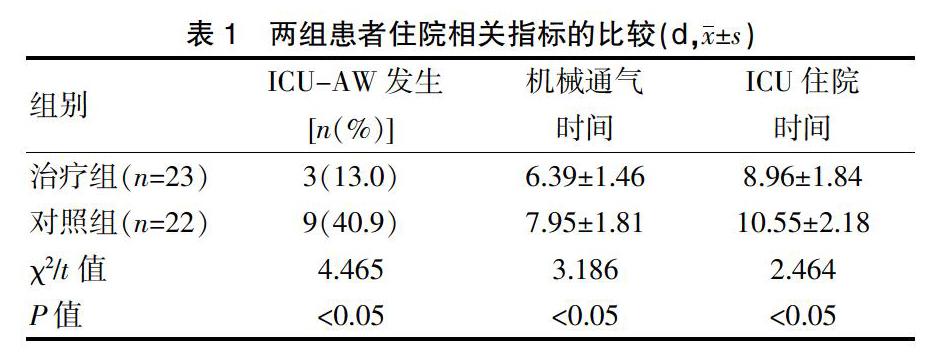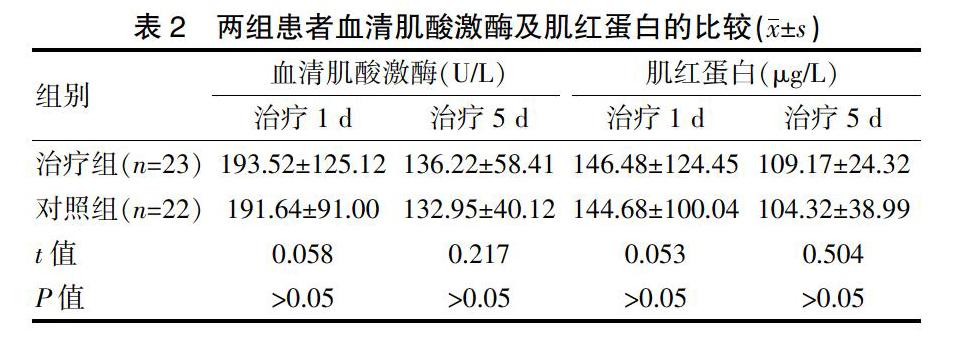早期神经肌肉电刺激在脓毒症机械通气患者治疗中的效果
2019-09-12许卓谦叶家骏姚淑雯李东华
许卓谦 叶家骏 姚淑雯 李东华


[摘要]目的 探讨早期神经肌肉电刺激在脓毒症机械通气患者治疗中的效果。方法 选取2017年2月~2018年12月我院收治的45例脓毒症机械通气患者作为研究对象,随机分为治疗组(23例)及对照组(22例)。治疗组在脓毒症标准化治疗的基础上,早期施加神经肌肉电刺激治疗,对照组只接受脓毒症标准化治疗。比较两组患者ICU获得性肌无力的发生率、机械通气时间、ICU住院时间、血清肌酸激酶及肌红蛋白变化。结果 治疗组患者ICU获得性肌无力发生率低于对照组,机械通气时间及ICU住院时间短于对照组,差异有统计学意义(P<0.05);两组患者治疗1、5 d后的血清肌酸激酶及肌红蛋白比较,差异无统计学意义(P>0.05)。结论 脓毒症机械通气患者早期实施神经肌肉电刺激,可预防ICU获得性肌无力的发生,缩短机械通气时间及ICU住院时间,值得临床应用。
[关键词]神经肌肉电刺激;ICU获得性肌无力;脓毒症;机械通气
[中图分类号] R657.3 [文献标识码] A [文章编号] 1674-4721(2019)6(c)-0055-03
[Abstract] Objective To explore the effect of early neuromuscular electrical stimulation in the treatment of sepsis patients with mechanical ventilation. Methods A total of 45 cases of sepsis patients with mechanical ventilation treated in our hospital from February 2017 to December 2018 were selected as the subjects, and randomly divided into treatment group (23 cases) and control group (22 cases). On the basis of standardized treatment of sepsis, the treatment group received neuromuscular stimulation in the early stage, while the control group only received standardized treatment of sepsis. The incidence of ICU acquired weakness, duration of mechanical ventilation, length of hospitalization of icu,serum creatine kinase and myoglobin were compared between the two groups. Results The incidence of ICU acquired weakness in the treatment group was lower than that in the control group, and the duration of mechanical ventilation and hospitalization of icu were shorter in the treatment group than in the control group (P<0.05). There was no significant difference in serum creatine kinase and myoglobin between the two groups after treatment of 1 and 5 days (P>0.05). Conclusion Early application of neuromuscular electrical stimulation to sepsis patients with mechanical ventilation can prevent the occurrence of ICU acquired weakness, reduce the duration of mechanical ventilation and the length of hospitalization of ICU, and it is worthy of clinical application.
[Key words] Neuromuscular electrical stimulation;ICU Acquired Weakness;Sepsis;Mechanical ventilation
隨着脓毒症规范化管理和集束化治疗的推行,严重脓毒症和脓毒性休克患者的病死率显著下降,但新的问题也随之突出:伴随着患者生存时间的延长,呼吸机依赖或脱机困难逐渐成为重症监护病房(ICU)和相关医疗机构的治疗难题,其发病率和病死率远高于脓毒症本身[1]。严重脓毒症患者呼吸机依赖的发生和发展除了和脓毒症导致的多器官功能障碍有关外,还与ICU有关的多种并发症相关,肌无力为脓毒症机械通气常见并发症,神经和肌肉功能障碍都是导致这种临床症状的原因,这些疾病被称为重症监护病房获得性肌无力(ICU-AW),由于并发ICU-AW引起患者脱机困难,患者停留ICU的时间增加,医疗费用大幅度上涨,死亡率增加,因此,针对呼吸机依赖的患者,治疗的重点除了脓毒症本身外,还要积极预防和治疗ICU-AW等并发症[2-3]。神经肌肉电刺激(NMES)被认为是一种替代运动的方法,是预防及治疗ICU-AW的一种方法,已证实其是安全可行的[4-6]。然而,对于最佳的NMES参数,如起始时间、剂量、电荷的选择、运动点的定位等目前还缺少共识,同时鉴于ICU-AW的危害性和难治性,目前的治疗策略已逐步转向早期预防为主的方向[7-8]。本研究选取45例脓毒症机械通气患者作为研究对象,旨在探讨早期神经肌肉电刺激在脓毒症机械通气患者治疗中的效果,现报道如下。
1资料与方法
1.1一般资料
选取2017年2月~2018年12月我院收治的45例脓毒症机械通气患者作为研究对象,随机分为治疗组(23例)和对照组(22例)。治疗组中,男15例,女8例;年龄27~75岁,平均(66±12)岁;急性生理与慢性健康评分(APACHE Ⅱ评分)(17.6±3.3)分。对照组中,男13例,女9例;年龄25~75岁,平均(63±13)岁;APACHEⅡ评分(17.9±3.5)分。两组患者的一般资料比较,差异无统计学意义(P>0.05),具有可比性。脓毒症的诊断符合《2016年脓毒症与脓毒性休克治疗国际指南》标准[9]。纳入标准:同时满足下列3项。①脓毒症;②年龄16~75岁;③接受机械通气且时间≤24 h。排除标准:①急性脑血管病变;②严重胸、腹部创伤;③急性心肌梗死、严重心律失常、心力衰竭和休克;④原发性神经肌肉病变;⑤恶性肿瘤晚期或恶液质;⑥慢性病终末期;⑦康复治疗禁忌者;⑧无书面知情同意书者。本研究已经医院医学伦理委员会批准,患者本人或监护人知情同意。
1.2方法
对照组只接受脓毒症标准化治疗,包括执行脓毒症出入院标准、广谱抗菌药物的使用、血流动力学支持、肺保护性通气策略、程序化镇静镇痛原则、血糖控制≤180 mg/L和早期肠内营养等规范。
治疗组在脓毒症标准化治疗的基础上,早期施加NMES治疗。NMES采用北京耀洋康达医疗仪器有限公司产KT-90系列神经肌肉电刺激仪。治疗者取仰卧位,将三组电极分别置于上肢肱三头肌、下肢股直肌、胫骨前肌的运动点(肌腹中央);选取神经肌肉电刺激仪第1档,脉冲波形为双向不对称方波,调制波为方波,脉冲频率为500 Hz,脉冲宽度为1 ms,调制波宽度为10 ms,调制波频率为1 Hz,(启动时间15 min)输出电流强度以能诱导靶肌产生收缩并无痛感为宜。左右两边各30 min,2次/d,5 d/周。①干预时机:患者转入ICU机械通气24 h后即开始干预,并满足以下条件:a.SaO2≥90%;b.血流动力学稳定:平均动脉压≥65 mmHg,无新发生的心律失常,多巴胺剂量≤10 μg/(kg·min)或去甲肾上腺素剂量≤0.1 μg/(kg·min)。②终止标准:发生下列任意一项,即予以终止试验。a.心血管事件如心律失常、低血压;血氧饱和度进行性下降;b.严重呼吸困难;c.严重人机不协调;d.意识障碍加重;e.导管脱落或移位。
1.3观察指标及评价标准
比较两组患者的ICU-AW发生率、机械通气时间、ICU住院时间、血清肌酸激酶及肌红蛋白水平。ICU-AW评定:使用英国医学研究委员会(medical research council,MRC)量表评分作为诊断ICU-AW的工具,MRC为6级肌力评定法,每级评分0~5分,通过双侧上肢(伸腕、屈肘、肩关节外展))及双侧下肢(足背屈、伸膝、屈髋)肌力对运动功能进行评价,MRC总分范围0(四肢瘫)~60分(肌力正常),若不能评定全部12个关节,则按实际评定的关节数计算平均分。如果总分≤48分,平均分≤4分可诊断为ICU-AW[10]。转出ICU前评分确定ICU-AW发生率。
1.4统计学方法
采用SPSS 19.0统计学软件对数据进行分析,计量资料以均数±标准差(x±s)表示,采用t检验,计数资料以率(%)表示,采用χ2检验,以P<0.05为差异有统计学意义。
2结果
2.1两组患者住院相关指标的比较
治疗组患者的ICU-AW发生率低于对照组,机械通气时间及ICU住院时间短于对照组, 差异有统计学意义(P<0.05)(表1)。
2.2两组患者血清肌酸激酶及肌红蛋白的比较
两组患者治疗1、5 d后的血清肌酸激酶及肌红蛋白比较,差异无统计学意义(P>0.05)(表2)。
3讨论
ICU-AW是重症患者常见的ICU相关并发症之一,ICU-AW的实质是神经肌肉功能障碍,包括危重病多发性神经病、危重病肌病及两者共存的危重症多神经肌病,其发生机制复杂[11]。ICU-AW常见于脓毒症机械通气伴呼吸机依赖、脱机困难的患者,一项95例的多中心前瞻性研究显示,病理证实的ICU-AW发病率为25.3%[12],在脓毒性休克的患者,发病率高达50%~100%[13]。与未罹患ICU-AW的患者比较,ICU-AW患者机械通气时间显著延长(P<0.05),住院病死率显著升高(P<0.01)[14]。其发生主要与原发疾病的危重程度有关,控制原发疾病,辅以一定的早期功能性活动,可以降低ICU-AW的发生率。NMES通过刺激神经纤维激活运动神经元、增加肌肉的血流量与收缩力,从而阻止肌肉萎缩,有助于降低ICU-AW的发生率,缩短机械通气的时间[15]。研究顯示,NMES可降低ICU-AW的发生率,同时也是安全可靠的,可早期实施,对肌肉无损伤,对机体氧供与代谢无影响[6,16]。
本研究通过对脓毒症机械通气患者早期实施NMES,结果显示,治疗组的ICU-AW发生率低于对照组,机械通气时间及ICU住院时间短于对照组(P<0.05),提示NMES可预防ICU-AW。肌酸激酶与肌红蛋白水平可反映骨骼肌损伤水平,相关研究显示,NMES会引起骨骼肌损伤导致肌酸激酶升高甚至引起肌溶解[17-18],但也有研究显示NMES对骨骼肌无明显损伤,肌酸激酸无明显改变[6,19-20],这可能与电刺激强度、时间、频率、疾病状态有关。本研究在治疗第1天与第5天测定肌酸激酸、肌红蛋白,结果显示,两组患者的血清肌酸激酶及肌红蛋白比较,差异无统计学意义(P>0.05),提示本研究所采用的NMES对骨骼肌无明显损伤,是安全的。
综上所述,对脓毒症机械通气患者早期实施NMES,可以预防ICU-AW的发生,缩短机械通气时间及ICU住院时间,值得临床应用。
[參考文献]
[1]Thille AW,Cortes-Puch I,Esteban A.Weaning from the ventilator and extubation in ICU[J].Curr Opin Crit Care,2013,19(1):57-64.
[2]浙江省早期规范化液体复苏治疗协作组.危重病严重脓毒症/脓毒性休克患者早期规范化液体复苏治疗—多中心、前瞻性、随机、对照研究[J].中国危重病急救医学,2010,22(6):331-334.
[3]Boles JM,Bion J,Connors A,et al.Weaning from mechanical ventilation[J].Eur Respir J,2007,29(5):1033-1056.
[4]Routsi C,Gerovasili V,Vasileiadis I,et al.Electrical muscle stimulation prevents critical illness polyneuromyopathy:a randomized parallel intervention trial[J].Crit Care,2010,14(2):R74.
[5]Rodriguez PO,Setten M,Maskin LP,et al.Muscle weakness in septic patients requiring mechanical ventilation:protective effect oftranscutaneous neuromuscular electrical stimulation[J].J Crit Care,2011,27(3):1-8.
[6]Silva PE,Babault N,Mazullo JB,et al.Safety and feasibility of a neuromuscular electrical stimulation chronaxie-based protocol in critical ill patients:a prospective observational study[J].J Crit Care,2017,37:141-148.
[7]Maffiuletti NA,Minetto MA,Farina D,et al.Electrical stimulation for neuromuscular testing and training: state-of-the art and unresolved issues[J].Eur J Appl Physiol,2011,111(10):2391-2397.
[8]Kho ME,Truong AD,Brower RG,et al.Neuromuscular electricalstimulation for intensive care unit-acquired weakness:protocoland methodological implications for a randomized,sham-controlled,phase Ⅱ trial[J].Phys Ther,2012,92(12):1564-1579.
[9]Rhodes A,EvansL E,Alhazzani W,et al.Surviving sepsis campaign:international guidelines for management of sepsis and septic shock:2016[J].Intensive Care Med,2017,43(3):304-377.
[10]Fan E,Cheek F,Chlan L,et al.An official American thoracic society clinical practice guideline:the diagnosis of intensive care unit-acquired weakness in adults[J].AM J Respir Crit Care Med,2014,190(12):1437-1446.
[11]Dos Santos CC,Batt J.ICU-acquired weakness:mechanisms ofdisability[J].Curr Opin Crit Care,2012,18(5):509-517
[12]De Jonghe B,Sharshar T,Lefaucheur JP,et al.Paresis acquired in the intensive care unit:a prospective multicenter study[J].JAMA,2002,288(22):2859-2867.
[13]Schweickert WD,Hall J.ICU-acquired weakness[J].Chest,2007,131(5):1541-1549.
[14]Garnacho-Montero J,Madrazo-Osuna J,Garcia-Garmendia JL,et al.Critical illness polyneuropathy:risk factors and clinical consequences.A cohort study in septic patients[J].Intensive Care Med,2001,27(8):1288-1296.
[15]Gerovasili V,Stefanidis K,Vitzilaios K,et al.Electrical muscle stimulation preserves the muscle mass of critically ill patients:a randomized study[J].Crit Care,2009,13(5):R161.
[16]Hirose T,Shiozaki T,Shimizu K,et al.The effect of electrical muscle stimulation on the prevention of disuse muscle atrophy in patients with consciousness disturbance in the intensive care unit[J].J Crit Care,2013,28(4):536.
[17]Guarascio P,Lusi EA,Soccorsi F.Electronic muscular stimulators:a novel unsuspected cause of rhabdomyolysis[J].Br J Sport Med,2004,38(4):505.
[18]Jubeau M,Sartorio A,Marinone PG,et al.Comparison between voluntary and stimulated contractions of the quadriceps femoris for growth hormone response and muscle damage[J].J Appl Physiol,2008,104(1):75-81.
[19]Moreau D,Dubots P,Boggio V,et al.Effects of electromyostimulation and strength training on muscle soreness,muscle damage and sympathetic activation[J].J Sport Sci,1995,13(2):95-100.
[20]Zorn C,Szekeres T,Keilani M,et al.Effects of neuromuscular electrical stimulation of the knee extensor muscles on muscle soreness and different serum parameters in young male athletes: preliminary data[J].Br J Sport Med,2007,41(12):914-916.
(收稿日期:2019-04-11 本文編辑:闫 佩)
